Executive Search User Guide
Overview
Executive Search is for managing hiring processes for Executive Search and Specialized Recruitment. Some of these features can also offer value to non-Executive Search customers.
Use the following links to jump to a section within this article:
Executive Search Data
Executive Search Data can be used and stored in multiple ways in .
Client![]() A Company is the organization where the contact works. This can also be called the Client. Account records contain details about past, current and potential Executive Search Client companies
A Company is the organization where the contact works. This can also be called the Client. Account records contain details about past, current and potential Executive Search Client companies![]() A Company is the organization where the contact works. This can also be called the Client., allowing you to research and target potential candidates
A Company is the organization where the contact works. This can also be called the Client., allowing you to research and target potential candidates![]() A person looking for a job. A candidate can also be referred to as a Job Seeker, Applicant, or Provider.. This information can also be added as an Account and associated with a particular engagement by adding it as a Target Account to the position Job record.
A person looking for a job. A candidate can also be referred to as a Job Seeker, Applicant, or Provider.. This information can also be added as an Account and associated with a particular engagement by adding it as a Target Account to the position Job record.
Accounts![]() A business entity/company are linked to candidates' contact details through Employment History records, which are generated when parsing their CV or adding them manually. Accounts may be known by different names or be associated with other companies. This information is managed by adding Account Alias records to an Account. They can also be grouped in an Account List, specifying associated information that can be reused when researching similar positions.
A business entity/company are linked to candidates' contact details through Employment History records, which are generated when parsing their CV or adding them manually. Accounts may be known by different names or be associated with other companies. This information is managed by adding Account Alias records to an Account. They can also be grouped in an Account List, specifying associated information that can be reused when researching similar positions.
As Candidates apply for roles they automatically become associated with the Client Account and their progress is tracked on the appropriate Job record.
Accounts
The following sections outline the types of actions you can take regarding Accounts.
Creating a New Account
Add a new account by following the steps below:
- Select Account.
- Click New.
- Fill out the required fields and any additional appropriate information.
- Click Save.
Creating an Account Alias
Account Alias names are added on an Account’s Related tab.
- Accounts with specified Account Aliases are automatically associated.
- Accounts associated with any Account Aliases found during Resume Parsing
 A process which converts an unstructured form of resume data into the structured format. are directly associated to a contact's Work History.
A process which converts an unstructured form of resume data into the structured format. are directly associated to a contact's Work History.
Follow the steps below to add a new account alias:
- Select New Account Alias. The Account name is automatically populated.
- Enter the Account Alias Name in the Account Alias Name field.
- Select an Alias Type from the dropdown.
- Alias Types for your Org are added based on typical commercial scenarios, for example:
- Alternative Names the Account may be known by.
- Names the Account previously traded under.
- Regional or localized names for the Account.
- Alias Types for your Org are added based on typical commercial scenarios, for example:
- Save.
Creating Account Lists
Account Lists can be created to group similar Accounts together to be used as a starting point when searching for Candidates for specific roles. The groupings can be based on a variety of factors such as industry sector, size and / or location.
To add an Account List follow the steps below:
- Open the Account List tab.
- Select New.
- Enter an Account List Name.
- Click Save.
- Select the Related tab.
- Select New to add each Account List Member.
- Search for the Account to add it to the list.
You can also create an Account List when research has been completed for a particular Job:
- Open the Job.
- Select Add Target Accounts from Account List.
A new Account List is generated including all the Accounts on a selected list and any additional Target Accounts added for the selected Job.
Creating Target Accounts
A Target Account extends the Account List functionality by specifying an Account, similar to a Hiring Client Account for a specific Job. This could be used for a variety of factors, such as industry sector, size, types of roles, types of processes performed, locations, or evolution stage.
To create a new Target Account follow the steps below:
- Open the Target Account tab.
- Select New.
- Fill out the following fields:
- Account: Select the Target Account if it is already saved.
- Account Name: Add the Account Name if it is not an existing record.
- Job: Select the Job you are hiring for.
- Status: Pick a status from the drop down. Common options are:
- Research Not Started
- Research In Progress
- Research Completed
- Notes: Enter any applicable notes.
- Source Account List: If you have grouped research into a Source Account List containing the Account, enter it here.
- Source: Enter the Source from which the Target Account was identified.
Target Accounts can be added in a number of other ways as well:
- From an existing Account record that is the target for a Job.
- From the Job’s Related tab.
- By adding all the Accounts in an Account List as Target Accounts to a specific Job by selecting Add Target Accounts from Account List and selecting the list.
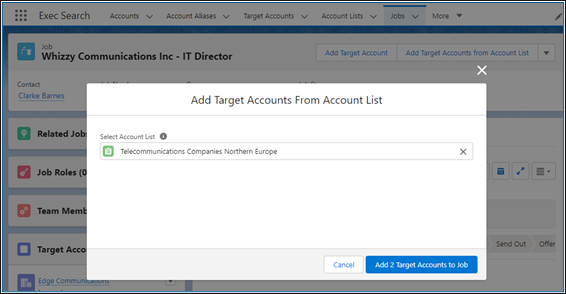
Contacts
Contacts![]() A contact (or client contact) is the person who the recruiter is working with at a Company. In Talent Rover a Contact can be either a Client Contact or a Candidate Contact. Both types of Contacts are stored in the same object (Contact). can be created, updated and viewed via the Contacts screen. They can also be added at various stages in the recruiting process - for example, during CV parsing for a new Candidate
A contact (or client contact) is the person who the recruiter is working with at a Company. In Talent Rover a Contact can be either a Client Contact or a Candidate Contact. Both types of Contacts are stored in the same object (Contact). can be created, updated and viewed via the Contacts screen. They can also be added at various stages in the recruiting process - for example, during CV parsing for a new Candidate![]() A person looking for a job. A candidate can also be referred to as a Job Seeker, Applicant, or Provider.. There are two types of Contacts:
A person looking for a job. A candidate can also be referred to as a Job Seeker, Applicant, or Provider.. There are two types of Contacts:
- Candidate Contacts: Available as potential hires or actively involved in the hiring process.
- Client Contacts
 A contact (or client contact) is the person who the recruiter is working with at a Company. In Talent Rover a Contact can be either a Client Contact or a Candidate Contact. Both types of Contacts are stored in the same object (Contact).: Associated with your Client Accounts. May work directly for a hiring company
A contact (or client contact) is the person who the recruiter is working with at a Company. In Talent Rover a Contact can be either a Client Contact or a Candidate Contact. Both types of Contacts are stored in the same object (Contact).: Associated with your Client Accounts. May work directly for a hiring company A Company is the organization where the contact works. This can also be called the Client. or be external contacts involved in that company’s hiring process.
A Company is the organization where the contact works. This can also be called the Client. or be external contacts involved in that company’s hiring process.
When creating a new contact, fill out all the mandatory fields and add as much detail as possible. The following fields have specific instructions:
- Candidate Status: Select Not Applicable if the Contact is not a Candidate.
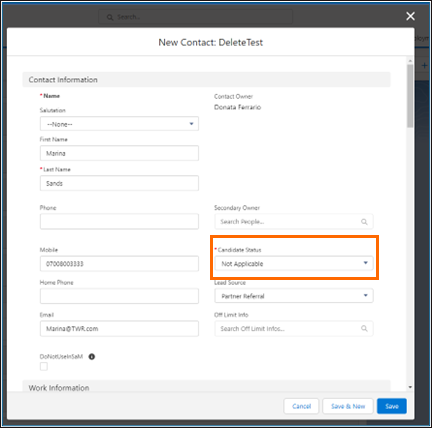
- Client Status: Select Not Applicable if the Contact is a Candidate.
- Account Name: Your Org will have one or more Account Names set up to assign Candidates to.
When adding a Contact, Executive Search automatically checks for duplicate Contacts. If duplicate records are found they display on the Contact Related tab.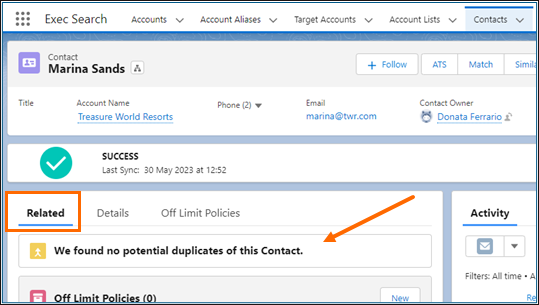
Creating a new Candidate Contact by parsing their CV (Global Actions > Resume Parser) automatically populates the Employment History into the Contact’s Related tab.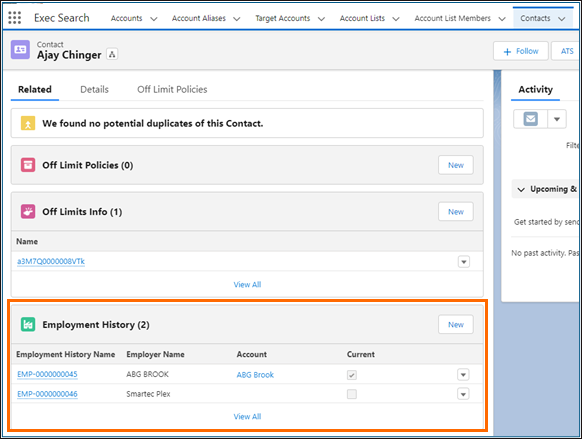
Jobs
Creating a New Job
Follow these steps to add a new assignment:
- Select New from the Jobs screen or the Jobs area on the Account > Related screen.
- Select the type of hire being added. For example, a Permanent role, a Consulting role or a Fixed Term Booking
 Fifth Stage of Job placement flow, a Candidate that reaches the Closing Report Placement stage has been assigned to a job. In Bullhorn Recruitment Cloud, a 'Closing Report' is a record that captures all the information related to the newly filled position (name of Candidate, position, salary, start date, which recruiter gets credit for the hire etc.).
Fifth Stage of Job placement flow, a Candidate that reaches the Closing Report Placement stage has been assigned to a job. In Bullhorn Recruitment Cloud, a 'Closing Report' is a record that captures all the information related to the newly filled position (name of Candidate, position, salary, start date, which recruiter gets credit for the hire etc.). - Fill out the following sections:
- Information: Fields containing basic information about the Job.
- Job Compensation: This may vary for different Jobs depending on the contractual agreements made with different Clients
 A Company is the organization where the contact works. This can also be called the Client. and specific hires, see Job Billing.
A Company is the organization where the contact works. This can also be called the Client. and specific hires, see Job Billing. - Job Requirements: Any requirements candidates need to apply for the Job.
- Job Internal Notes: Information about location and target dates.
- Save.
Additional information can be added directly from a selected Job screen or by opening the relevant tab for the information being entered.
Creating Job Roles
Job Roles are used to relate Contacts to Jobs where they have a specific role in the hiring process. The Contact may work for the Client Company (a Client Contact![]() A contact (or client contact) is the person who the recruiter is working with at a Company. In Talent Rover a Contact can be either a Client Contact or a Candidate Contact. Both types of Contacts are stored in the same object (Contact).) or may be hired as an associate or consultant to assist in the hiring process (Jury Member).
A contact (or client contact) is the person who the recruiter is working with at a Company. In Talent Rover a Contact can be either a Client Contact or a Candidate Contact. Both types of Contacts are stored in the same object (Contact).) or may be hired as an associate or consultant to assist in the hiring process (Jury Member).
Job Roles can be selected to populate associated email addresses when emails are sent from a Job record.
Job Roles can be added in the following ways:
- Select New Job Role
 A Job Role is a defined set of responsibilities, permissions, and expected tasks assigned to a user or group within a system or organization. Job Roles determine what actions a user can take, what information they can access, and how they interact with workflows or features. from the Job screen.
A Job Role is a defined set of responsibilities, permissions, and expected tasks assigned to a user or group within a system or organization. Job Roles determine what actions a user can take, what information they can access, and how they interact with workflows or features. from the Job screen. - Select New from the Job Role screen.
- Select one or more Contacts and click the New Job Role button.
Include the following information when creating a new Job Role:
- Contact
- Job
- Role
- Notes
Your Org may be configured to automatically create Job Roles on a Job. If this is enabled, Job Role records are automatically generated when Contact and Hiring Manager![]() The person that approves/rejects Consultant's Timesheets/Expenses (usually a Client Contact, or Hiring Manager) details are added to a Job record.
The person that approves/rejects Consultant's Timesheets/Expenses (usually a Client Contact, or Hiring Manager) details are added to a Job record.
These can be viewed on the Job record and are shown as Derived to indicate that the source of the information came from the Job record.
Creating Related Jobs
Related Jobs are similar Jobs as they often contain previous research that can be applied and may list suitable Candidates to target. Follow these steps to create a new Related Job:
- From a Job’s Related List, Select Related Job > New.
- You can also select one or more Jobs and click Add Related Job.
- Fill out the following fields:
- Job: This field is auto populated.
- Related to Job: Search for the Job.
- Status: Select from the drop down.
- Research Not Started
- Research in Progress
- Research Completed
- Notes: Add any Notes regarding the similarities or difference in the Job roles.
The Related Jobs can be viewed and used to add Candidates to other Jobs from the Job record.
Team Member Credits
Team Member Credits can be used to credit user involvement over the course of the hiring process. There are three default types of credit phases (shown as percentages) included in Executive Search:
- Origination Credit %: Contribution to finding or winning the opportunity
 Potential sales to new or established customers..
Potential sales to new or established customers.. - Conversion Credit %: Contribution to converting the opportunity to a live Job.
- Execution Credit %: Contribution to delivering the Job to completion.
Multiple users can contribute to the same credit category and values can be reset at different stages of billing. Team Member Credits are viewed, added and updated by users with the associated permissions on the Job screen or the Related tab of a Job. Team Members are selected from existing users.
Companies have individual approaches for managing Team Member Credits and the approaches implemented may depend on a number of factors such as the type of hire, sector or geographical region. Custom validation rules may be created for specific business cases.
Job Billing
The Billing process for different Job searches varies depending on the contractual agreements made with different clients and specific hires. Jobs may have a number of billing events at different key stages, for example, completing research, submitting a specified number of candidates or attaining a hire.
Executive Search enables the framework for this using two key features: Projected and Actual Billing.
In the Job Compensation section of the Jobs details page, Projected and Actual Billing details fields are included. These can be customized according to your commercial practices, linked to automations and flows to manage the Billing Process and linked to external invoicing systems. The available fields are:
- Projected Fee: Agreed retainment to cover the costs of preliminary setup and research for the Job hiring process.
- Projected Base Package: Estimated Salary Package available for new hire.
- Projected Bonus: Estimated Bonus for first year.
- Sum Projected Base and Bonus: The sum of the projected base and bonus packages.
- Actual Base Salary: Final Salary.
- Actual Bonus: Confirmed Bonus for first year.
- Actual Total: Compensation for first year.
Tasks can be created and marked as Billing Events. New tasks are added on the Task screen and can be assigned to one or more users. If the task is marked as a Billing Event![]() A Salesforce term used to describe an activity that involves invitations being sent out and calendar appointments being made., it can trigger a billing process or send a notification to designated billing users when completed.
A Salesforce term used to describe an activity that involves invitations being sent out and calendar appointments being made., it can trigger a billing process or send a notification to designated billing users when completed.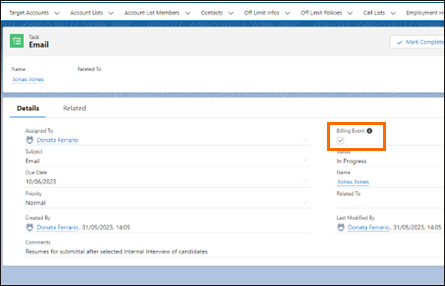
The billing process can be configured based on the practices used by your organization and individual commercial agreements. For further information and questions contact Support.